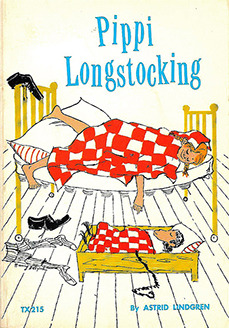She also is a child anarchist against adult discipline.
I read these books as a child, and even as a child I did not so much live vicariously through Pippi’s rebellion against the parents, teachers, and other authorities she encountered, as I gasped along with her straight-man friends Tommy and Annika at her improprieties and hidden loneliness.
Because, even though she lives in a children’s book, Pippi is like a real person.
She has good qualities—including her superhuman strength and never-ending cheer—and since she is the titular character we can’t help but root for her against burglars and other villains like “pluttifikation.”
But then there is the other side of Pippi, which makes her human and fallible as if she weren’t a literary hero. She is ignorant—oh, she’s clever enough, but she lacks education. She can barely read (!!!!), which means if she were a real person she wouldn’t be able to read her own stories. She also is rude. For every gift she gives on her birthday there’s an occasion for her being thoughtless about others, or disrespectful of elders. And then there’s the whole situation with her living alone in Villa Villekulla with a horse and a monkey while her father abandons her for a cannibal kingdom….
She has good qualities—including her superhuman strength and never-ending cheer—and since she is the titular character we can’t help but root for her against burglars and other villains like “pluttifikation.”
But then there is the other side of Pippi, which makes her human and fallible as if she weren’t a literary hero. She is ignorant—oh, she’s clever enough, but she lacks education. She can barely read (!!!!), which means if she were a real person she wouldn’t be able to read her own stories. She also is rude. For every gift she gives on her birthday there’s an occasion for her being thoughtless about others, or disrespectful of elders. And then there’s the whole situation with her living alone in Villa Villekulla with a horse and a monkey while her father abandons her for a cannibal kingdom….
 |
| Source: http://media.tumblr.com/tumblr_lojdq0njXk1qi6jm3.jpg |
If I’m making these books sound sad as well as
eclectically awesome, that’s pretty much a fair summing up of Astrid Lindgren's Pippi books. These
books are mainly centered on farce: on a girl who lives alone and takes care of
herself with a suitcase of gold and the inability to keep both stockings pulled
up on her legs at once. The stories are
meant to be laughed at, not taken seriously. Yet they were also written in a time where even nonsense books for
children held some deeper emotional impact for the reader than just a barrel o’
laughs. I feel like this is not so much
a trend in recent juvenile publications.
My favorite book of this series, by the way, is Pippi in the South Seas, where Pippi is reunited with her absentee father, fights a shark, and thwarts pearl-thieves from attacking their island tribe of cannibals.
I was influenced by the books in such various ways as liking to give people gifts on my birthday, or sleeping with my head at the “foot” of the bed. My hair never WOULD stick out straight in pigtails, though, no matter how hard I tried at it.
RECOMMENDED READING AGE: 8+; there isn’t anything crude
or inappropriate for younger readers, but the idea that Pippi is an orphan
living alone who sometimes encounters perilous situations (even when she takes it in stride) might be
frightening. There also is a maturity
factor in that the reader has to be able to distinguish which characteristics are
admirable in Pippi Longstocking, and which behaviors they should avoid
emulating (such as: don’t make up scurrilous lies about distant cultures).
PARENTAL NOTES: As I said, Pippi is not a good role model
for children who are having issues respecting adult authority figures. (An argument could be made that this includes
all children at one point or another.) She also is a compulsive liar.
AVAILABILITY: Sadly a lot of Pippi Longstocking books
have been relegated to paperback reprints or “the new adventures” which may be
an abridged or altered version of the original stories.

I always wondered how much wire they had to put inside the young actress' pigtail braids to make them stand out straight!
ReplyDelete